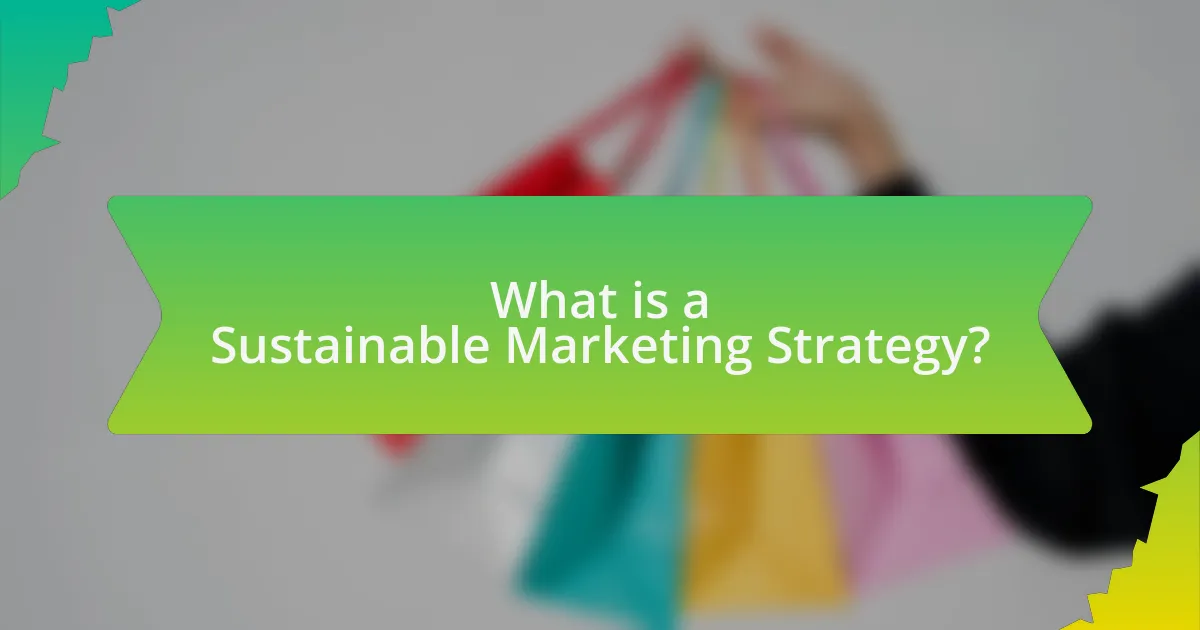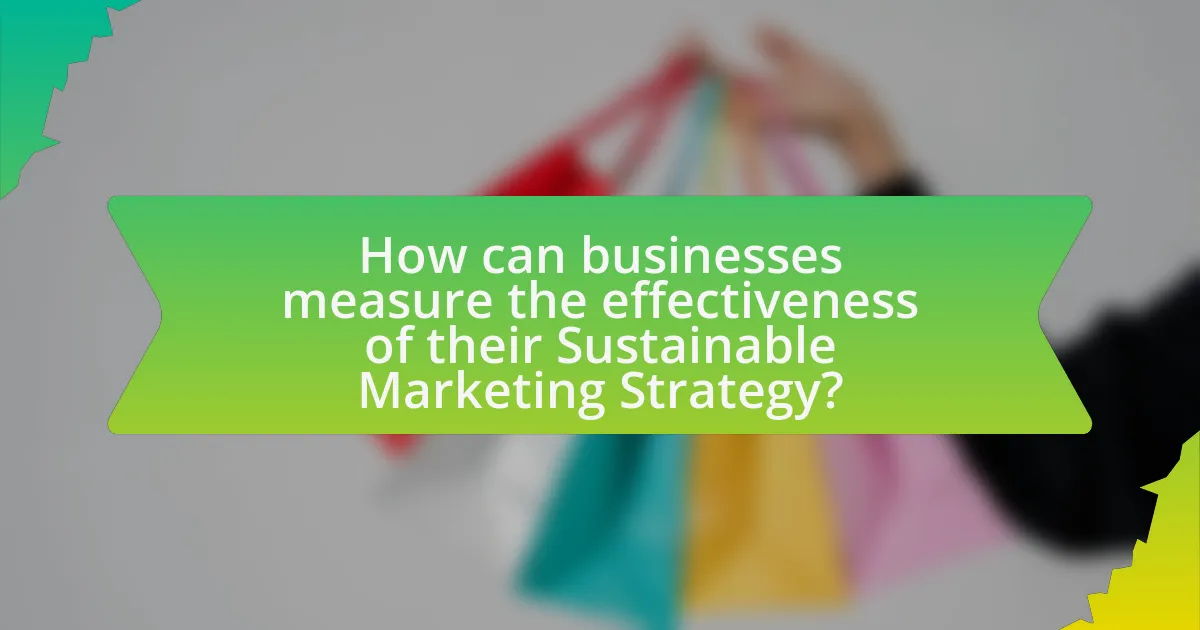A sustainable marketing strategy integrates environmental, social, and economic considerations into marketing practices, aiming to create long-term value for businesses and society. This article outlines the differences between sustainable and traditional marketing, emphasizing the importance of transparency, ethical sourcing, and consumer engagement. It discusses the core components of sustainable marketing, the significance of aligning marketing strategies with consumer values, and the challenges businesses face in implementation. Additionally, it highlights successful examples and best practices for developing effective sustainable marketing strategies, providing insights into measuring their impact and the role of collaboration and storytelling in promoting sustainability.

What is a Sustainable Marketing Strategy?
A sustainable marketing strategy is a plan that integrates environmental, social, and economic considerations into marketing practices to create long-term value for both the business and society. This approach emphasizes responsible resource use, ethical consumerism, and transparency, aiming to meet the needs of current consumers without compromising the ability of future generations to meet their own needs. Research indicates that companies adopting sustainable marketing strategies can enhance brand loyalty, improve customer satisfaction, and achieve competitive advantages, as seen in a 2020 study by the Harvard Business Review, which found that 64% of consumers are willing to pay more for sustainable brands.
How does a Sustainable Marketing Strategy differ from traditional marketing?
A Sustainable Marketing Strategy focuses on long-term environmental and social impacts, while traditional marketing primarily emphasizes short-term sales and profit maximization. Sustainable marketing integrates eco-friendly practices and ethical considerations into its core, aiming to create value for both consumers and the planet. For example, companies like Patagonia prioritize sustainability in their branding and product offerings, which resonates with environmentally conscious consumers and fosters brand loyalty. In contrast, traditional marketing often relies on mass advertising and consumerism without addressing ecological or social consequences, leading to potential negative impacts on brand reputation and customer trust.
What are the key principles of sustainability in marketing?
The key principles of sustainability in marketing include transparency, ethical sourcing, consumer engagement, and long-term value creation. Transparency involves openly communicating a brand’s practices and impacts, fostering trust with consumers. Ethical sourcing emphasizes the importance of obtaining materials and products in a manner that is socially responsible and environmentally friendly, which can enhance brand reputation and loyalty. Consumer engagement focuses on involving customers in sustainability efforts, encouraging them to participate in initiatives that promote environmental stewardship. Long-term value creation prioritizes sustainable practices that benefit both the business and society, ensuring that marketing strategies contribute positively to the environment and community. These principles are supported by research indicating that brands adhering to sustainable practices often experience increased customer loyalty and market share.
Why is sustainability important in today’s marketing landscape?
Sustainability is crucial in today’s marketing landscape because it aligns with consumer values and drives brand loyalty. Research indicates that 66% of global consumers are willing to pay more for sustainable brands, demonstrating a clear market demand for environmentally responsible practices. Companies that prioritize sustainability not only enhance their reputation but also attract a growing demographic of eco-conscious consumers, ultimately leading to increased sales and long-term success.
What are the core components of a Sustainable Marketing Strategy?
The core components of a Sustainable Marketing Strategy include ethical sourcing, eco-friendly practices, social responsibility, and stakeholder engagement. Ethical sourcing ensures that materials are obtained in a manner that is fair and environmentally responsible, which is crucial for building consumer trust. Eco-friendly practices involve minimizing waste and reducing carbon footprints throughout the marketing process, aligning with consumer preferences for sustainability. Social responsibility emphasizes the importance of contributing positively to communities and society at large, which can enhance brand loyalty. Lastly, stakeholder engagement involves actively communicating with and considering the interests of all parties affected by the business, fostering transparency and collaboration. These components collectively support long-term success by aligning business practices with consumer values and environmental stewardship.
How do target audience insights influence sustainability efforts?
Target audience insights significantly influence sustainability efforts by guiding organizations in aligning their practices with consumer values and preferences. Understanding the demographics, behaviors, and attitudes of the target audience allows companies to tailor their sustainability initiatives to meet specific expectations, thereby enhancing engagement and support. For instance, a study by Nielsen found that 66% of global consumers are willing to pay more for sustainable brands, indicating that insights into consumer preferences can drive businesses to adopt more eco-friendly practices. This alignment not only fosters brand loyalty but also encourages companies to innovate in sustainability, ensuring that their efforts resonate with the values of their audience.
What role does brand messaging play in sustainable marketing?
Brand messaging plays a crucial role in sustainable marketing by effectively communicating a brand’s commitment to environmental and social responsibility. This messaging helps to build trust and loyalty among consumers who prioritize sustainability in their purchasing decisions. Research indicates that 66% of global consumers are willing to pay more for sustainable brands, highlighting the importance of clear and authentic brand messaging in attracting this demographic. Furthermore, consistent and transparent messaging reinforces a brand’s values, differentiating it from competitors and fostering long-term customer relationships.
What challenges do businesses face in implementing a Sustainable Marketing Strategy?
Businesses face several challenges in implementing a Sustainable Marketing Strategy, primarily including high costs, lack of consumer awareness, and difficulty in measuring impact. High costs arise from the need for sustainable materials and processes, which can strain budgets, especially for small businesses. Lack of consumer awareness limits demand for sustainable products, making it challenging for businesses to justify the investment in sustainable practices. Additionally, measuring the impact of sustainable marketing efforts can be complex, as businesses often struggle to quantify benefits such as brand loyalty and customer engagement. These challenges hinder the effective adoption of sustainable marketing strategies, impacting long-term success.
How can companies overcome resistance to change in marketing practices?
Companies can overcome resistance to change in marketing practices by fostering a culture of open communication and involving employees in the change process. Engaging team members in discussions about the benefits and rationale behind new marketing strategies can reduce apprehension and build buy-in. Research indicates that organizations that prioritize employee involvement in decision-making experience a 30% higher success rate in implementing changes (Kotter, 1996). Additionally, providing training and resources to help employees adapt to new practices can further ease the transition, as studies show that well-supported change initiatives lead to improved employee morale and productivity.
What are the common misconceptions about sustainable marketing?
Common misconceptions about sustainable marketing include the belief that it is only about environmental issues, that it is a niche market, and that it is more expensive than traditional marketing. Sustainable marketing encompasses social, economic, and environmental dimensions, not just ecological concerns. Additionally, it is increasingly mainstream, with consumers demanding sustainable practices across various industries, thus broadening its appeal beyond a niche. Furthermore, while some sustainable practices may have higher upfront costs, they often lead to long-term savings and increased customer loyalty, making them financially viable.

How can businesses measure the effectiveness of their Sustainable Marketing Strategy?
Businesses can measure the effectiveness of their Sustainable Marketing Strategy through key performance indicators (KPIs) such as customer engagement, brand perception, and sales growth. By tracking metrics like social media interactions, customer feedback on sustainability initiatives, and changes in market share, companies can assess how well their sustainable practices resonate with consumers. For instance, a study by Nielsen found that 66% of global consumers are willing to pay more for sustainable brands, indicating that increased sales can reflect successful sustainable marketing efforts. Additionally, businesses can utilize surveys and analytics tools to gather data on consumer attitudes towards their sustainability initiatives, providing concrete evidence of the strategy’s impact.
What metrics should be used to evaluate sustainability in marketing?
Key metrics to evaluate sustainability in marketing include carbon footprint, waste reduction, resource efficiency, and social impact. Carbon footprint measures the total greenhouse gas emissions associated with marketing activities, providing insight into environmental impact. Waste reduction tracks the decrease in materials used and discarded, indicating efficiency in resource management. Resource efficiency assesses how effectively resources are utilized in marketing campaigns, reflecting sustainability practices. Social impact evaluates the positive effects on communities and stakeholders, highlighting the ethical dimension of marketing efforts. These metrics collectively offer a comprehensive view of sustainability in marketing strategies.
How can customer feedback inform the success of sustainable initiatives?
Customer feedback can significantly inform the success of sustainable initiatives by providing insights into consumer preferences and perceptions regarding sustainability efforts. This feedback allows organizations to understand which sustainable practices resonate with customers, enabling them to tailor their initiatives accordingly. For instance, a study by Nielsen found that 66% of global consumers are willing to pay more for sustainable brands, indicating that customer preferences can drive the adoption of sustainable practices. By analyzing feedback, companies can identify areas for improvement, enhance customer satisfaction, and ultimately increase the effectiveness of their sustainability strategies.
What tools are available for tracking sustainability performance?
Tools available for tracking sustainability performance include software platforms like EcoStruxure, Sphera, and Enablon. These tools provide functionalities such as data collection, analysis, and reporting on various sustainability metrics, including carbon emissions, energy usage, and waste management. For instance, EcoStruxure offers real-time monitoring and analytics, enabling organizations to optimize their resource use and reduce environmental impact. Sphera specializes in environmental, health, and safety management, helping companies comply with regulations and improve sustainability practices. Enablon provides a comprehensive suite for managing sustainability data, allowing businesses to track progress against their sustainability goals effectively.
How does consumer behavior impact Sustainable Marketing Strategies?
Consumer behavior significantly impacts sustainable marketing strategies by influencing how companies design their offerings and communicate their values. When consumers prioritize sustainability, businesses adapt their marketing strategies to highlight eco-friendly practices, such as using sustainable materials or reducing carbon footprints. For instance, a Nielsen report from 2015 indicated that 66% of global consumers are willing to pay more for sustainable brands, demonstrating that consumer preferences drive companies to adopt sustainable practices to meet market demand. This alignment between consumer behavior and marketing strategies not only enhances brand loyalty but also fosters a competitive advantage in the growing market for sustainable products.
What trends are emerging in consumer preferences for sustainability?
Emerging trends in consumer preferences for sustainability include a significant shift towards eco-friendly products, increased demand for transparency in sourcing, and a preference for brands that demonstrate social responsibility. Consumers are increasingly prioritizing products made from sustainable materials, with a 2022 survey indicating that 66% of global consumers are willing to pay more for sustainable brands. Additionally, there is a growing expectation for brands to disclose their environmental impact and ethical practices, as 73% of millennials express a desire for transparency in the brands they support. This trend is reinforced by the rise of social media, where consumers actively seek out and share information about sustainable practices, influencing purchasing decisions.
How can businesses align their marketing strategies with consumer values?
Businesses can align their marketing strategies with consumer values by conducting thorough market research to understand the values and preferences of their target audience. This alignment can be achieved through the integration of sustainability practices, ethical sourcing, and transparent communication in marketing campaigns. For instance, a Nielsen report indicates that 66% of consumers are willing to pay more for sustainable brands, demonstrating that aligning marketing strategies with consumer values can enhance brand loyalty and drive sales. By actively engaging with consumers and adapting to their evolving values, businesses can create more relevant and impactful marketing strategies that resonate with their audience.

What are the best practices for developing a Sustainable Marketing Strategy?
The best practices for developing a Sustainable Marketing Strategy include integrating sustainability into the core business model, engaging stakeholders, and measuring impact. Companies should align their marketing efforts with sustainable practices, such as using eco-friendly materials and promoting social responsibility. Engaging stakeholders, including customers and employees, fosters a sense of community and shared values, which can enhance brand loyalty. Additionally, measuring the impact of sustainability initiatives through metrics like carbon footprint reduction or community engagement levels provides concrete evidence of effectiveness and areas for improvement. Research by the Harvard Business Review indicates that companies with strong sustainability practices can outperform their competitors financially, reinforcing the importance of these best practices.
How can companies effectively integrate sustainability into their marketing plans?
Companies can effectively integrate sustainability into their marketing plans by aligning their brand values with sustainable practices and communicating these efforts transparently to consumers. This approach involves adopting eco-friendly materials, reducing waste, and promoting social responsibility initiatives, which resonate with the growing consumer demand for ethical products. For instance, a Nielsen report indicates that 66% of global consumers are willing to pay more for sustainable brands, highlighting the market potential for companies that prioritize sustainability in their marketing strategies. By showcasing their commitment to sustainability through targeted campaigns and authentic storytelling, companies can enhance brand loyalty and attract environmentally conscious consumers.
What role does collaboration play in enhancing sustainable marketing efforts?
Collaboration significantly enhances sustainable marketing efforts by fostering innovation and resource sharing among stakeholders. When businesses, non-profits, and communities work together, they can combine expertise and resources to create more impactful marketing strategies that promote sustainability. For instance, a study by the Harvard Business Review found that companies engaging in cross-sector collaborations are 50% more likely to achieve their sustainability goals. This synergy not only amplifies the reach of sustainable messages but also builds trust and credibility among consumers, ultimately leading to increased brand loyalty and market share.
How can storytelling be used to promote sustainability in marketing?
Storytelling can be used to promote sustainability in marketing by creating emotional connections that resonate with consumers’ values and beliefs about environmental responsibility. This approach allows brands to communicate their sustainability efforts in a relatable and engaging manner, making complex issues more accessible. For example, brands like Patagonia effectively use storytelling to highlight their commitment to environmental causes, showcasing real-life impacts of their initiatives, such as their “Don’t Buy This Jacket” campaign, which encourages consumers to consider the environmental cost of consumption. This strategy not only raises awareness but also fosters brand loyalty among consumers who prioritize sustainability, as evidenced by a Nielsen report indicating that 66% of global consumers are willing to pay more for sustainable brands.
What are some successful examples of Sustainable Marketing Strategies?
Successful examples of sustainable marketing strategies include Patagonia’s “Don’t Buy This Jacket” campaign, which encouraged consumers to consider the environmental impact of their purchases, leading to increased brand loyalty and sales. Another example is Unilever’s Sustainable Living Plan, which aims to reduce the company’s environmental footprint while enhancing social impact, resulting in a significant increase in sales from sustainable brands. Additionally, IKEA’s commitment to using renewable and recycled materials in its products has strengthened its market position and consumer trust. These strategies demonstrate that aligning marketing efforts with sustainability can drive both brand success and positive environmental outcomes.
Which brands are leading the way in sustainable marketing practices?
Patagonia, Unilever, and Tesla are leading the way in sustainable marketing practices. Patagonia is renowned for its commitment to environmental activism, exemplified by its “Don’t Buy This Jacket” campaign, which encourages consumers to consider the environmental impact of their purchases. Unilever has integrated sustainability into its core business strategy, with its Sustainable Living Plan aiming to reduce its environmental footprint while increasing positive social impact. Tesla promotes sustainability through its electric vehicles and renewable energy products, positioning itself as a leader in the transition to sustainable energy. These brands demonstrate effective sustainable marketing by aligning their business practices with environmental and social responsibility, thereby influencing consumer behavior and industry standards.
What lessons can be learned from successful sustainable marketing campaigns?
Successful sustainable marketing campaigns demonstrate the importance of authenticity, consumer engagement, and measurable impact. Authenticity builds trust; brands like Patagonia have thrived by aligning their marketing with genuine environmental commitments, resulting in increased customer loyalty. Consumer engagement is crucial; campaigns that involve customers in sustainability efforts, such as Coca-Cola’s “World Without Waste,” have shown higher participation rates and brand affinity. Lastly, measurable impact is essential; campaigns that track and report their sustainability outcomes, like Unilever’s Sustainable Living Plan, provide transparency and accountability, which resonate with consumers increasingly concerned about corporate responsibility. These lessons highlight the need for brands to integrate sustainability into their core values and marketing strategies for long-term success.
What practical steps can businesses take to implement a Sustainable Marketing Strategy?
Businesses can implement a Sustainable Marketing Strategy by integrating sustainability into their core values and practices. This involves conducting a sustainability audit to assess current practices, identifying areas for improvement, and setting measurable sustainability goals. For instance, companies can adopt eco-friendly materials, reduce waste, and promote energy-efficient processes. Additionally, businesses should engage stakeholders, including customers and suppliers, to foster a culture of sustainability. Research indicates that 66% of consumers are willing to pay more for sustainable brands, highlighting the market demand for such strategies. By aligning marketing efforts with sustainable practices, businesses can enhance brand loyalty and drive long-term success.


